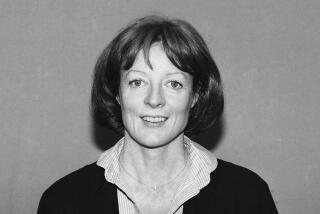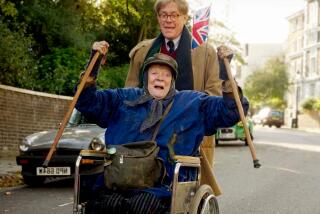Marvin Smith, 93; He, Twin Depicted Life in Harlem
- Share via
Marvin Smith, who with his identical twin, Morgan, chronicled Harlem’s workaday life from the 1930s to the ‘50s in photographs and other media, has died. He was 93.
Smith died Nov. 9 in Manhattan of unspecified causes after having suffered from Parkinson’s disease. His brother died of cancer in 1993.
The twins, rediscovered nationally in the 1990s for their contributions to art and history, worked so closely throughout their careers of photography, painting, sculpture, and television camera and sound technology that they signed their work jointly: “M & M Smith” or occasionally “Morgan Marvin Smith.”
“That’s the way my mother said it: ‘I’m callin’ you, Morgan-Marvin; come here,’ ” Smith joked for NPR in 1998 as he visited an exhibit of the brothers’ work at New York’s Schomburg Center for Research in Black Culture.
A PBS documentary first broadcast in 1995 was called “M & M Smith: For Posterity’s Sake -- the Lives and Work of Renowned Harlem Renaissance Photographers Morgan and Marvin Smith.” The program was narrated by actress Ruby Dee and featured singer Eartha Kitt, both of whom the Smiths had photographed at the outset of their careers.
“Whatever we did, we did for the both of us. The work is not mine; it’s ours,” Smith told People magazine in 1998 after the University of Kentucky Press published a book on their work, “Harlem: The Vision of Morgan and Marvin Smith.”
The book featured 100 of the 150 photos included in the Schomburg exhibit with a like number of the brothers’ paintings, sculptures and personal items.
“Trust is the signature of much of the Smith brothers’ work,” the San Francisco Chronicle stated in a book review. “Only a black photographer could have made their pictures of Nat King Cole dancing at his wedding, Joe Louis at ease in training camp, Josephine Baker giving children candy or ordinary folks milling on a Harlem street in Easter Sunday finery.... Rather than focus on [African American life’s] difficulty, they tried to evoke its normalcy, an ordinary decency of life that may have been more available morally than economically to most Harlem residents.”
The Smiths’ photos were also featured in the 1996 book “Visual Journal, Harlem and D.C. in the Thirties and Forties,” published by Smithsonian Press.
Their work has been exhibited at the Smithsonian Institution in Washington and at museums around the country, including the California Afro-American Museum in Los Angeles’ Exposition Park.
Born Feb. 16, 1910, to a sharecropper and his wife on a farm near Nicholasville, Ky., the twins had a natural affinity for art -- competing with each other in copying images from the Sears, Roebuck catalog.
The Smiths moved to Lexington, Ky., when they were 12, and the boys were the first in their family to graduate from high school. Marvin Smith took art lessons as payment for working as a houseboy for a white artist, and the boys set up a photo studio in their basement after a friend gave them a box camera.
In 1933, they moved to New York City, where they got jobs with the city Parks Department and took art lessons under the Federal Arts Program, an arm of the Depression-era Works Progress Administration.
They married identical twin sisters they met in art class -- and divorced them on the third anniversary of the double wedding. (Morgan remarried and fathered a daughter, but Marvin remained single.)
The Smiths set up their photo studio near Harlem’s Apollo Theater in 1939 and maintained it until 1968. During World War II, Marvin Smith enlisted in the Navy and became the first African American to attend the Naval Air Station School of Photography and Motion Pictures in Pensacola, Fla. Afterward, he used the G.I. Bill to study painting in Paris. From their commercial photo studio, the brothers shot portraits, weddings, birthdays and parades and covered news events, including Adam Clayton Powell’s anti-lynching demonstrations of the 1940s and “Don’t Buy Where You Can’t Work” protests.
They also photographed African American “firsts” -- the first black policeman, first black woman juror, first black woman streetcar driver.
The studio became a gathering place for celebrities, and the Smiths snapped their visitors as well as clients and the performers at the nearby Apollo.
One of their most famous celebrity photos is of a rakish Fats Waller at the piano, but the list also includes Langston Hughes at a typewriter, Billie Holiday in concert, a young sparsely clad dancer named Maya Angelou long before she became a famous author, and Jackie Robinson teaching his young son how to hold a baseball bat.
Others to come before their camera were Dee, Kitt, Harry Belafonte, Sidney Poitier, Redd Foxx, Duke Ellington, Marian Anderson, Pearl Bailey, Ossie Davis and W.E.B. DuBois.
From 1954 until retiring in 1975, both brothers worked in the television industry, Morgan mainly as a sound engineer and Marvin concentrating on set decorating. In the 1970s, Marvin turned his design talents to creating crochet patterns for McCall’s magazine.
More to Read
The biggest entertainment stories
Get our big stories about Hollywood, film, television, music, arts, culture and more right in your inbox as soon as they publish.
You may occasionally receive promotional content from the Los Angeles Times.










